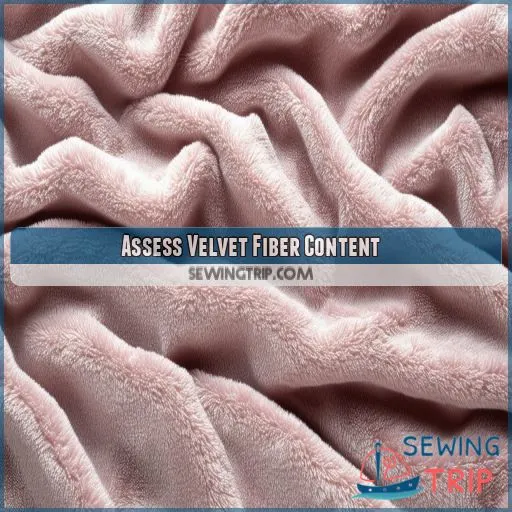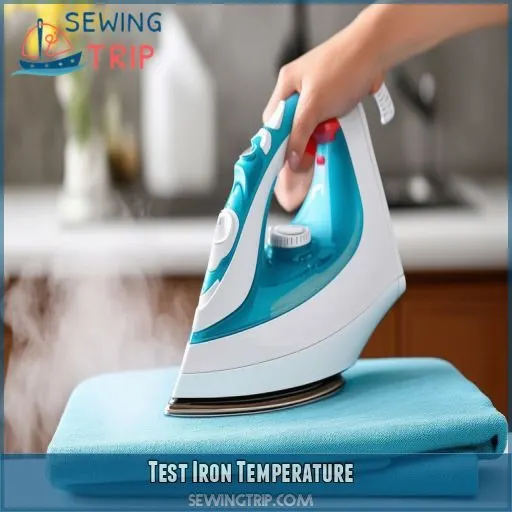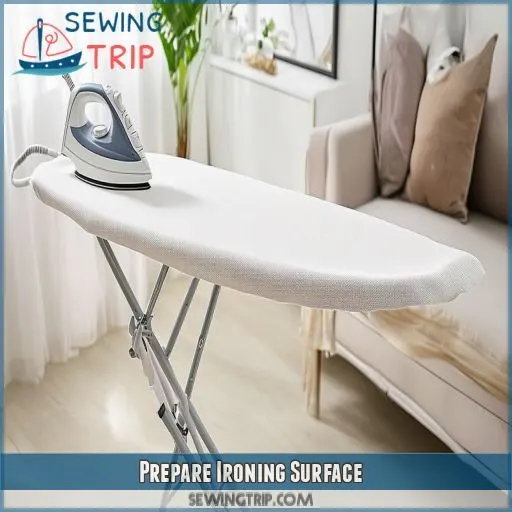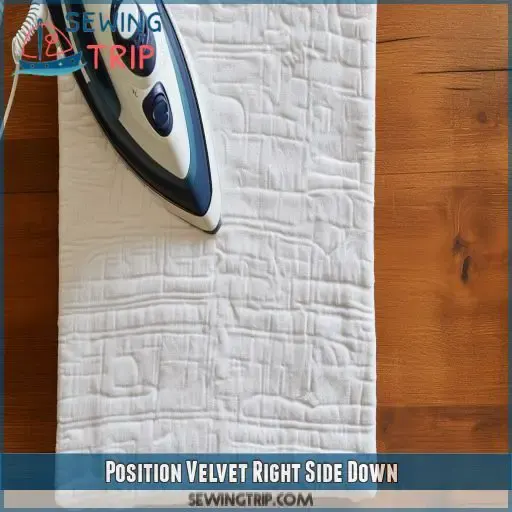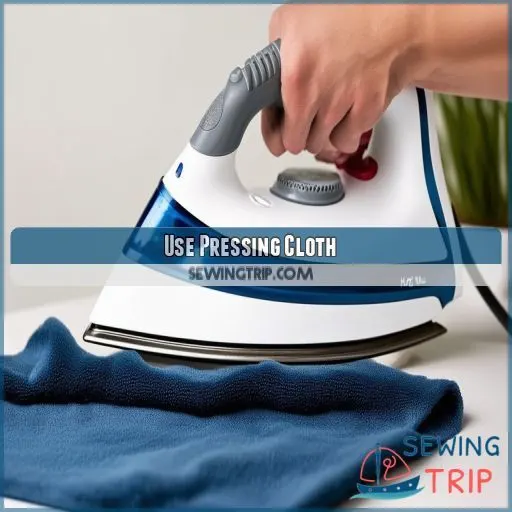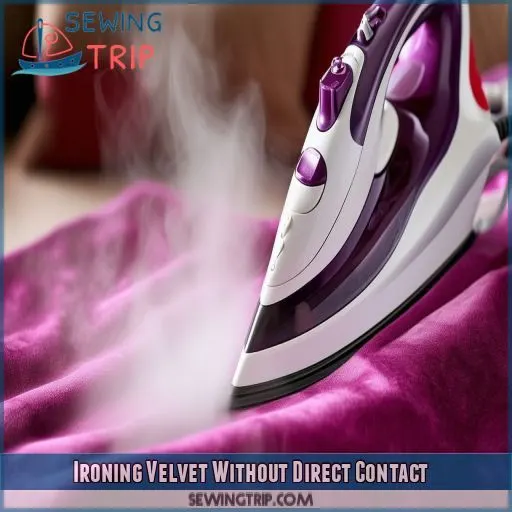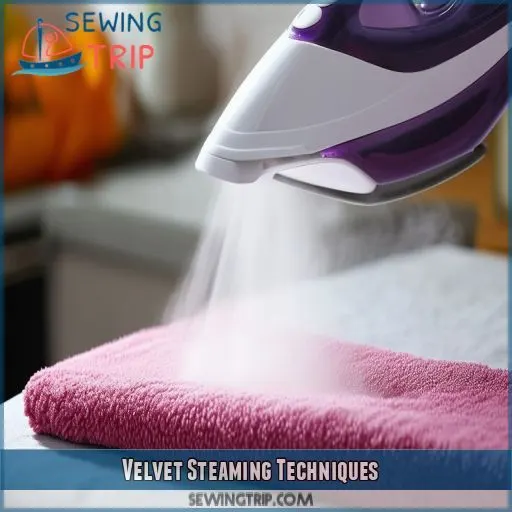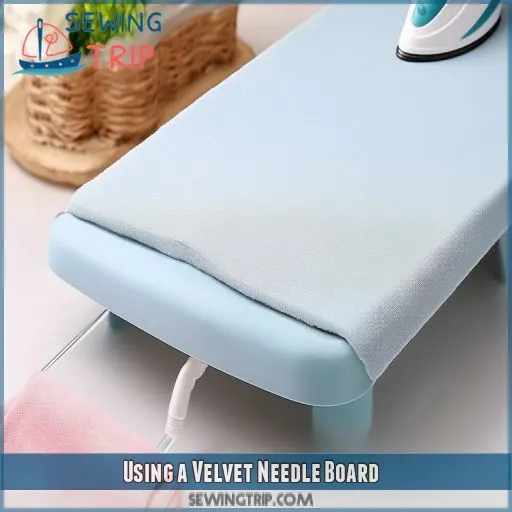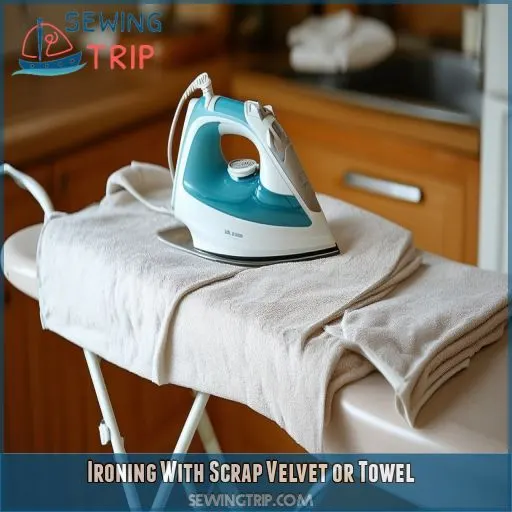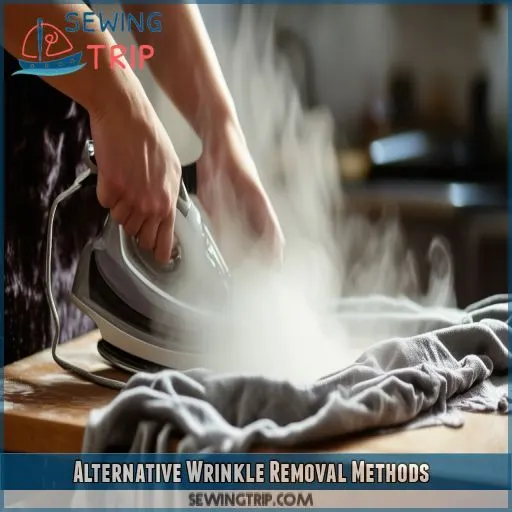This site is supported by our readers. We may earn a commission, at no cost to you, if you purchase through links.
 This ironing of velvet, however, may be a bit tricky if certain techniques are not applied. Here’s a 9-pro tip guide to help one in getting wrinkle-free results every time when ironing velvet fabric and keeping the luxurious texture and look of the material.
This ironing of velvet, however, may be a bit tricky if certain techniques are not applied. Here’s a 9-pro tip guide to help one in getting wrinkle-free results every time when ironing velvet fabric and keeping the luxurious texture and look of the material.
You will learn several important steps of assessing the fiber content, testing the temperature of your iron, and using the correct tools.
Whether it’s a velvet dress or upholstery, these methods will help you master the act of velvet care. You can say goodbye to creases and hello to flawlessly smooth velvet.
Table Of Contents
- Key Takeaways
- How to Iron Velvet Fabric Successfully?
- Assess Velvet Fiber Content
- Test Iron Temperature
- Prepare Ironing Surface
- Position Velvet Right Side Down
- Use Pressing Cloth
- Ironing Velvet Without Direct Contact
- Velvet Steaming Techniques
- Using a Velvet Needle Board
- Ironing With Scrap Velvet or Towel
- Alternative Wrinkle Removal Methods
- Frequently Asked Questions (FAQs)
- Conclusion
Key Takeaways
Ironing velvet is like taming a wild horse: it requires patience, skill, and the right tools. Don’t be afraid to experiment with different ironing methods until you find what works best for your velvet fabric. Remember, less pressure is more when ironing velvet! If you’re unsure about how to iron a particular piece of velvet, always consult a professional dry cleaner.
How to Iron Velvet Fabric Successfully?
To iron velvet fabric successfully, start by checking the fiber content on the label—silk, cotton, or synthetics each need different care.
Test the iron temperature on an inconspicuous area, beginning low.
Prepare your ironing surface with a velvet board or thick towel, and always place the fabric right side down.
Use a pressing cloth to shield the pile, and hover the iron about an inch above, using steam to relax wrinkles gently.
Interested in mastering velvet care? Stick around for more pro tips on keeping velvet wrinkle-free.
Assess Velvet Fiber Content
Before you start ironing those pesky velvet wrinkles, take a little while to get acquainted with your fabric. Check the fiber velvet blend on the label—it can be silk, cotton, or synthetic.
Look at the structure and height of your velvet pile. Move your hand along its surface to know the nap direction; this is very important in ironing.
Consider velvet weave types since some weaves are more delicate than others. This assessment will guide your ironing approach to ensure that you don’t ruin the luxurious pile.
Test Iron Temperature
Now that you have identified the fiber content of your velvet, you want to test the iron temperature. You want to strike a middle ground in which you remove the wrinkles but avoid burning the material. Start low and build up as needed. Do remember the type of velvet requires different ways of treatment:
- Silk velvet: Low temperature (250-275°F) and low pressure of steam
- Velvet cotton: Usually safe with medium heat and steam
• Synthetic velvet: Use the lowest heat possible, with care
- Crushed velvet: Avoid direct iron contact, use steam only
Always test on an inconspicuous area first, and never apply any direct pressure to the velvet’s pile.
Prepare Ironing Surface
To prepare your ironing surface for velvet, you’ll need a few specialized tools. Start with a velvet ironing board or a regular board covered with a thick towel. This cushioned surface protects the fabric’s delicate nap.
Next, set your iron to the correct velvet iron temperature, typically low heat with steam. Have a spray bottle handy for light misting if needed.
For extra care, consider using a pressing cloth to shield the velvet from direct contact with the iron.
Position Velvet Right Side Down
Set up your ironing surface, then put your velvet the right way. Always place the material on the wrong side of the fabric on your ironing board. This crucial step keeps the tender nap of velvet safe from direct contact with heat.
If you have curtains or other big pieces, spread them out in a careful, wrong-side-up manner. Now, inspect for seams and edges and make sure they’re lying flat.
If it feels a little tricky at first, don’t worry—you’ll get the feel in no time!
Use Pressing Cloth
When ironing velvet, a pressing cloth is your secret weapon. Place it between the iron and the velvet to protect the delicate fabric. Choose a thin, lint-free cotton cloth or a specialized pressing cloth for best results. Dampen the cloth slightly to enhance steam production and wrinkle removal. Always position the pressing cloth over the entire section you’re working on, paying extra attention to seams and embellishments.
- Feel like a fabric whisperer as you coax out wrinkles
- Conquer your fear of ruining that precious velvet dress
- Master the art of pressing without leaving a mark
- Become the go-to expert for velvet care among friends
- Transform from velvet novice to confident fabric pro
Ironing Velvet Without Direct Contact
Iron your velvet a distance of about an inch off the fabric. Go really slow across the surface, allowing the steam to penetrate and relax the fibers, so you don’t crush the pile. Use a pressing cloth to separate the iron from the velvet for extra protection.
What’s involved is the fragility of the fabric. You’ll keep wrinkles away by letting the steam work.
For velvet upholstery or larger pieces, you’ll need alternative methods, like hanging them in a steamy bathroom.
When you learn to iron velvet fabric, there’s no need to rush through the process.
Velvet Steaming Techniques
Steaming is your secret weapon for velvet fabric care. You’ll preserve that luxurious nap while banishing wrinkles.
Hang your velvet piece and fire up a garment steamer on its lowest setting. Glide it over the fabric from bottom to top, keeping a few inches distance.
No steamer? No problem! Transform your bathroom into a steam room. Hang the velvet item, run a hot shower, and let the moisture work its magic for 30 minutes.
For stubborn creases, try the iron-as-steamer method. Set it to cool steam and hover above the fabric, never touching it directly.
Using a Velvet Needle Board
Using a velvet needle board is a game-changer for ironing velvet. Place your garment face-down on the board, ensuring the pile sinks into the needles. Set your iron to the lowest heat setting and gently glide it over the fabric’s back. The needles prevent crushing the delicate pile while allowing wrinkles to disappear.
- Needle board placement: Always face-down
- Needle board material: Usually metal or plastic with fine bristles
- Needle board substitutes: Velvet pressing mat or thick terry cloth towel
- Needle board maintenance: Clean with a soft brush after use
- Needle board heat settings: Always use the lowest possible
Ironing With Scrap Velvet or Towel
If you happen not to have a velvet needle board, don’t worry about that because you can still improvise by using a scrap piece of velvet or a thick towel. Place the scrap velvet or the towel on your ironing board, with the pile side up.
With this, drape your velvet piece face down above it, ensuring that the drape of the fabric is natural. Now, using the lowest steam setting, hover the iron delicately over your fabric. It should weigh just enough to produce steam without pressing.
This method is ideal for maintaining velvet thickness and completely avoiding creases. Remember, less pressure is more when ironing velvet!
Alternative Wrinkle Removal Methods
Don’t fret if traditional ironing methods aren’t your cup of tea. There are several alternative ways to tackle those pesky velvet wrinkles:
- Velvet steamer: Hang your garment and gently steam from bottom to top.
- Hand steamer: Perfect for on-the-go touch-ups, especially for delicate velvet items.
- Fabric shaver: Carefully remove any pilling to refresh the velvet’s texture.
- Wrinkle spray: Mist lightly and hang to dry for minor creases.
For stubborn wrinkles or valuable pieces, consider professional dry cleaning. Remember, patience is key when dealing with velvet. Treat it gently, and you’ll keep that luxurious look for years to come.
Frequently Asked Questions (FAQs)
Can velvet fabric be ironed?
Yes, you can iron velvet fabric. Turn it inside out, use an iron at 300°F, and avoid direct pressure. Steam fabric beforehand and handle gently to prevent damage. Always check the manufacturer’s label for specific care instructions.
How to get the wrinkles out of velvet?
To remove wrinkles from velvet, hang the fabric, use a steamer’s lowest setting, or hold an iron an inch away with steam. Be careful, avoid direct contact, and let the steam relax the fibers.
How to get rid of pressure marks on velvet?
Ah, the dreaded pressure marks on your beloved velvet – a true test of your ironing prowess! Fear not, my friend. Gently mist the fabric, then float the iron just above, coaxing those pesky creases away with a featherlight touch. Velvet’s delicate nature demands your utmost care.
How to iron a design on velvet?
Place the velvet design face down on a towel. Set your iron to the lowest steam setting. Hover above the fabric, allowing steam to smooth wrinkles without direct contact. Use light pressure and avoid pressing firmly.
How to store velvet after ironing?
Let the velvet cool thoroughly after ironing. Fold or hang it gently to preserve its velvety texture. Properly caring for velvet in storage preserves the plush pile for years to come.
Best type of iron for velvet fabrics?
For velvet, one should be using a steam iron with heat variable anywhere between 250-300°F. It should also have a soleplate that doesn’t stick so it won’t ruin the delicate material.
Can you steam velvet upholstery?
While velvet upholstery may seem delicate, you can absolutely steam it! Just be sure to use the lowest heat setting and keep the steamer an inch away to avoid crushing the nap. With a gentle touch, you’ll have revived velvet in no time.
How to prevent velvet from crushing?
To prevent velvet from crushing, always steam instead of ironing directly, hang the fabric when steaming, and avoid applying direct pressure. Use a velvet needle board or lay a towel underneath for added protection.
Suitable detergents for cleaning velvet?
When cleaning velvet, opt for a mild, pH-balanced detergent. Avoid harsh chemicals that could damage the delicate fibers. Gently blot stains with a clean cloth and let the velvet air dry completely before storing or wearing.
Conclusion
Think of ironing velvet like taming a wild horse; it requires the right skills and tools.
By following these 9 pro tips on how to iron velvet fabric successfully, you’ll maintain its luxurious texture and achieve wrinkle-free results.
Remember to assess the fiber content, test the iron’s temperature, and use techniques like a pressing cloth and steam.
Master these methods and you’ll keep your velvet looking pristine, whether it’s a dress or upholstery.

